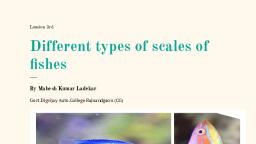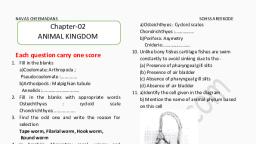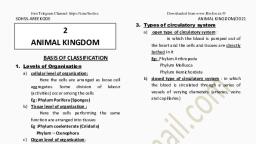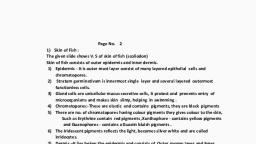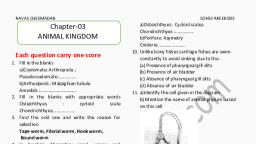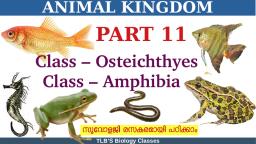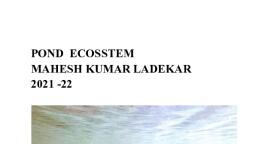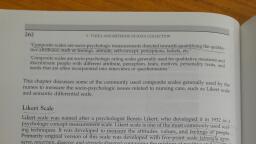Page 2 :
2, , INTRODUCTION, In many vertebrates, the exoskeletal covering of body is made of two types of scales- epidermal, and dermal. Epidermal scales are cornified derivatives of the Malpighian layer of epidermis., They are well developed in terrestrial vertebrates such as reptiles, birds and mammals. Dermal, scales are mesenchymal in origin and especially developed in the fishes., They are small, thin, cornified, calcareous or bony plates which fit closely together or overlap, , DEFINITION, , A fish scale is a small rigid plate that grows out of the skin of a fish. ... Scales vary enormously, in size, shape, structure, and extent, ranging from strong and rigid armour plates in fishes such, as shrimpfishes and boxfishes, to microscopic or absent in fishes such as eels and anglerfishes., , MKL
Page 5 :
5, , TYPES OF SCALE, Two different types of scales are present in fishes, (A) Placoid scale, (B) Non placid scale:, It is further divided into three types:, 1. Cosmoid scale, 2. Ganoid scale:, (a)Palaeoniscoid, , (b)Lepidosteoid, , 3. Bony-Ridge scale:, (a) Cycloid scale, , (b) Ctenoid scale, , (A) Placoid scale:, , MKL
Page 6 :
6, , ●, , These are also called as dermal denticles found in the sharks, , ●, , In structure placoid scale resembes a tooth., , ●, , Though the placoid scales are closely set but do not overlap each other, , ●, , Each scale consists of two parts : (a) a rhomboidal basal plate embeded in the, dermis and (b) a flat trident spine, projecting outward through the epidermis., , ●, , The basal plates consist of calcified tissue., , ●, , The trident spines are curved and directed posteriorly there by minimizing water, friction., , ●, ●, , each spine consist of dentine covered with a hard layer of vitrodentine ., The dentine encloses a pulp- cavity which opens below through the basal plate., Through this opening , blood vessels and nervs enter the pulp- cavity., , ●, , Placoid scales found in elasmobranches are very much similar to the dentine, ostracoderms., , MKL
Page 7 :
7, , Cosmoid scales:, , ●, , These scale where abundantly found in primitive members of sarcopterygii, cross, pterygii and the dipnoi., , ●, , The only living members with cosmoid scale arerepresented by the genus, Latimeria., , ●, , Cosmod scales are regarded as the precursor of the ganoid and the bony scales of, the modern teleostes., , ●, , Each cosmoid scale consists of following three layers:, 1. Isopedine: This is the inner layer consisting of layer bone., ●, , It is pierced by cannels for blood vessels., , 2. Vascular layer: This is the middle layer consisting of spongy bone and contains, numerous vascular spaces., 3. Cosmine: This is the outer layer made of dentine containing pulp cavity., , MKL
Page 8 :
8, , Ganoid scale:, , ●, , Thse are of two following types:, , ●, , 1. Palaeoniscoid ganoid scale: Such scale where f ound on primitive and extinct, actinopterygians and on extant controsteans, the polypterus., , ●, , In this type; (1) The layered bone isopedine is present. (2) The spongy bone is, absent. (3) The cosmine layer is reduce. (4)Above the cosmine layer is the hard, multilayered ganoine, which land the lustrous sheen to the scale., , ●, , 2. Lepisosteoid ganoid scale:Such scale are found on more recent chondrostean,, viz. Lepisosteus. In this type, spongy bone and cosmoid layer both are absent the, ganoin contain many tubules.Such scale arrenged closely together, like tiles on a floor, in diagonal rows., , MKL
Page 10 :
10, , ●, , The cycloid scales are thin, flexible, transluscent plates, rather circular in outline,, thicker in the centre and marked with several concentric lines of growth which can be, used for determining the age of the fish. They are found in a large number of teleostean, fishes having soft rayed fins, such as Labeo, Catla, Barbus, Cirrhina, etc. The central part, of the scale is called the focus and is the first part to develop. In many species, oblique, grooves or radii run from the focus towards the margin of the scale., , ●, , They form a protective covering over the skin and project diagonally in an imbricating, pattern. The part of the scale which is exposed to view in situ condition (posterior area), generally shows less distinct ridges or circuli and chromatophores are also sometimes, attached to it. The anterior area lies embedded in the skin., , MKL
Page 11 :
11, , Ctenoid Scales:, , ●, , The ctenoid scales are also circular and can be distinguished from the cycloid scales by, having a more or less serrated free edge. Moreover, several spines are present on the, surface of the posterior area of the scale. These scales are characteristic of modem, higher teleosteans such as perch, sunfish, etc., , ●, , They are more firmly attached and their exposed free hind parts which are not, overlapped, bear numerous small comb-like teeth or spines. Intermediate types between, cycloid and ctenoid scales are also found on different parts of the body. Certain fishes,, , MKL















